The social and economic consequences on losing your job and income due to the pandemic COVID-19 vary across EU countries. In the current health crisis, it is essential to rapidly provide information on the effects on income distribution in 2020. Policy makers work on these data and design the exit plans for a speedy EU Recovery.
Euro area unemployment at 7.9%
EU at 7.2%
July 2020
Workers most hit by the COVID crisis are young, low skilled, workers in accommodation and food sectors. These workers are often overrepresented in the low income group. Inequalities of COVID impact on labour and income in the EU. Low income workers more likely to lose their job or to be on layoffs.
Losing your job in the EU in Q2
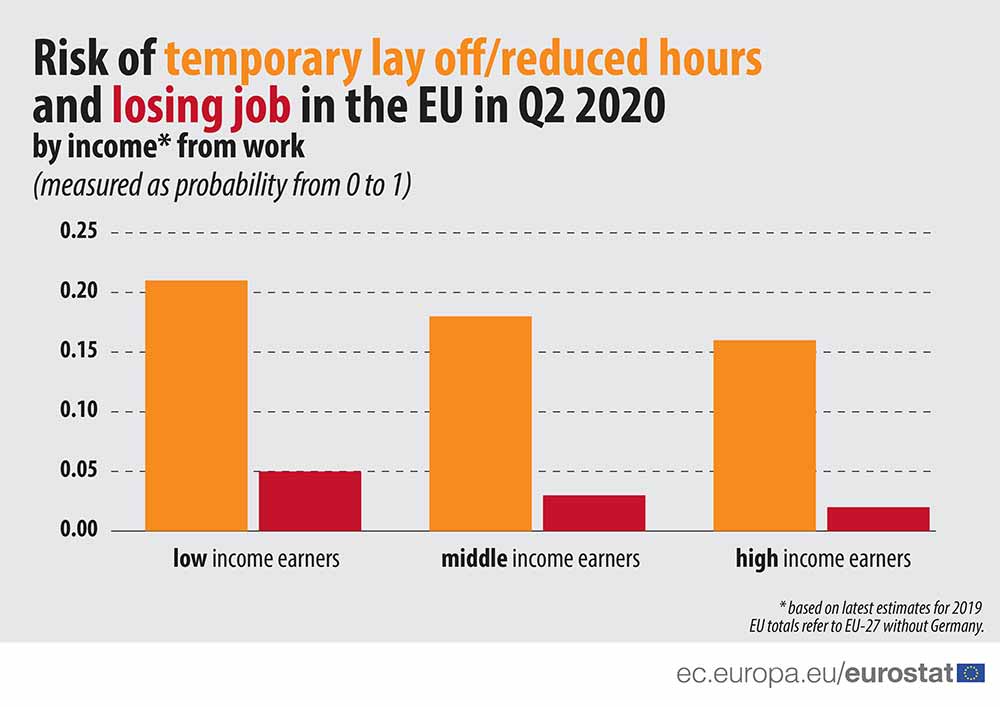
This EUROSTAT outcome presents the first experimental results linking the labour market impact of COVID-19 on the most affected categories of workers with their income situation.
The situation on losing your job differs from country to country
The social and economic consequences of the pandemic vary across countries. The labour impact is higher in particular in Spain, Italy, Cyprus, Ireland and Greece.
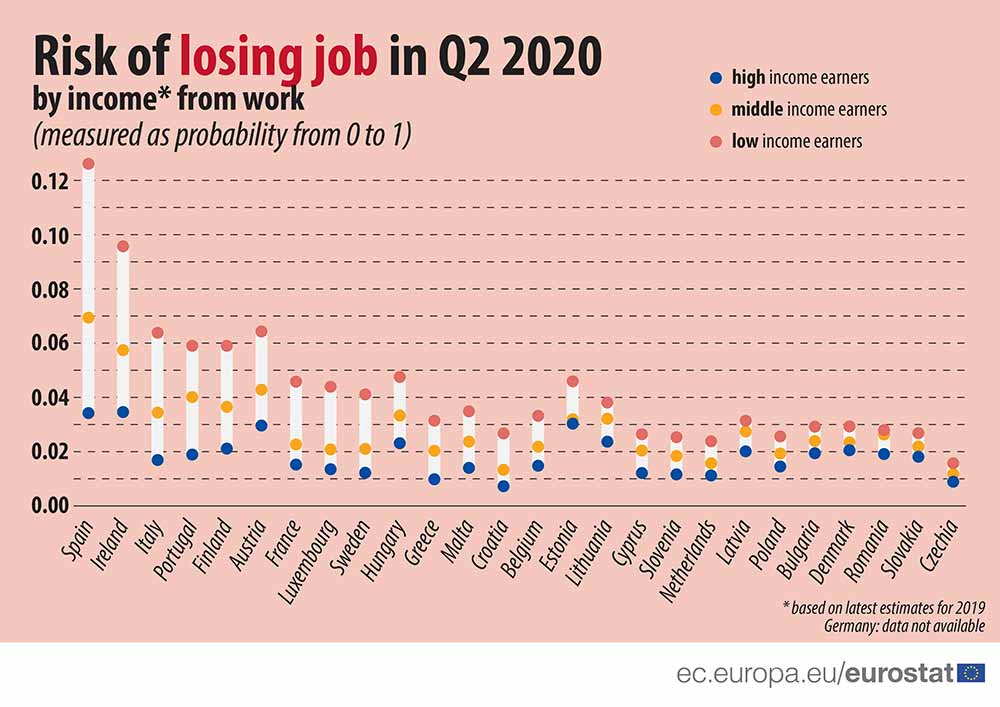
The changes on the labour market in 2020 in the EU considered most relevant for the purpose of our analysis are the increase in the number of workers losing their job and the sharp drop in working hours due to the lockdown. These overall trends are translated into distributional information by assessing the risk of individuals. This risk means either “losing your job” or having reduced working hours. Reduction of working hours can range from people on layoff or people working part time. The period of research is at the peak of the COVID crisis in quarter 2.
COVID19 Lockdown effects
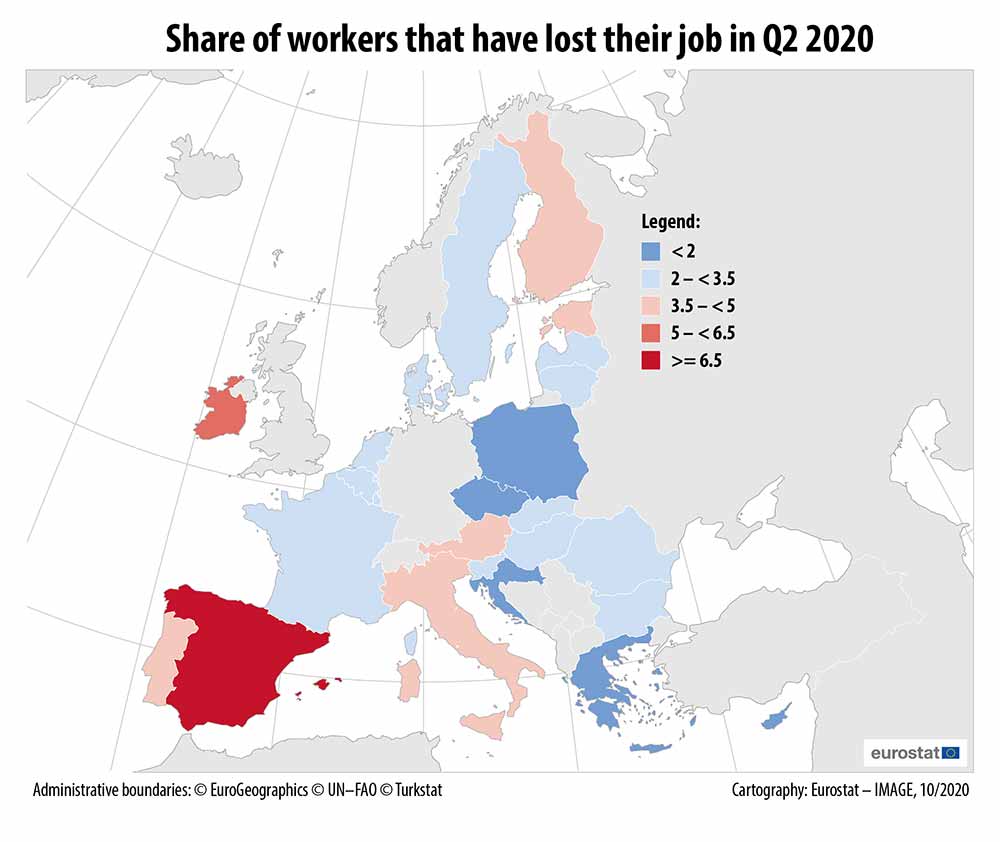
This risk is then correlated with their relative position in the income distribution in 2019 before the crisis. At the income level, the first risk would translate by the loss of income from work. The second case the worker is likely to enter wage compensation schemes put in place by the different Member States to buffer the effects of the lockdown.
Generally, the risk of facing a loss of income and deeper poverty varies widely across age groups, economic sectors and countries. In labour markets, temporary layoffs (including reduced working hours) concerned millions of workers, while the risk of losing one’s job was more limited, as it was mitigated by short-term support schemes.
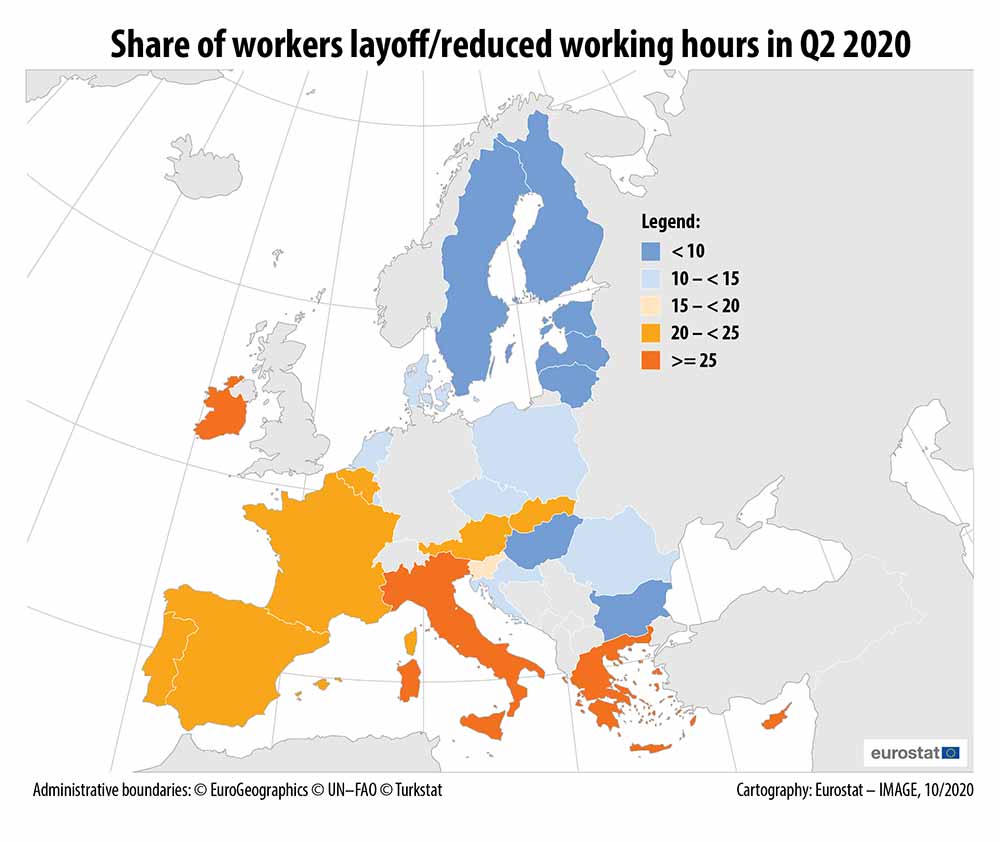
This analysis covers the labour market part of the standard nowcasting methodology extended to 2020. It highlights the most at risk categories given the evolution observed in the latest detailed labour market data available for 2020 and its potential effects on income and poverty.
The risk of income loss is concentrated
In general the “risk” of facing a loss of income and deeper poverty has different patterns across the two dimensions analysed (layoffs/reduced hours versus losing job) and varies substantially across age categories, economic sectors and countries. While the lay-offs/reduced hours concern millions of workers in the EU[4] with very large shares across countries, the effect on unemployment was mitigated by the wage compensation schemes.
The COVID crisis and the temporary lay-offs have a strong sectorial dimension. The highest risk for a worker to be on temporary layoff in the EU is in the accommodation and food sector.
Layoffs / reduced hours versus Losing your job

In the current extraordinary context of the pandemic and the related lockdown, it becomes essential to provide earlier information. Policy makers are able to assess the first effects on the income distribution in 2020.
EUROSTAT already released this year flash estimates on income and poverty, but they refer to income year 2019. This article presents the first experimental results. The outcome links the labour market impact of COVID-19 on the most affected categories of workers with their income situation. The labour shock impacted the whole working population. In most EU countries labour risks are highly unequal across the income distribution with vulnerable individuals being more likely to experience further income losses.
This analysis relies on modelling and it therefore incorporates a high level of uncertainty and partial information. The full impact will be consolidated in a later stage when the information on temporary policy measures introduced in different countries in order to support households’ income and workers will be available.
Employment in sport and fitness
In the second quarter of 2020, 801 700 people aged over 15 in the EU were employed in the sports and fitness sector. This labour sector represents 0.4% of total employment in the EU.
The majority of sports workers were men (57%) and almost one in two sports workers (48%) were aged between 15-34 years. Almost a third (30%) were aged 35-49 years and 23% were aged 50 or above.
European sports and fitness workers
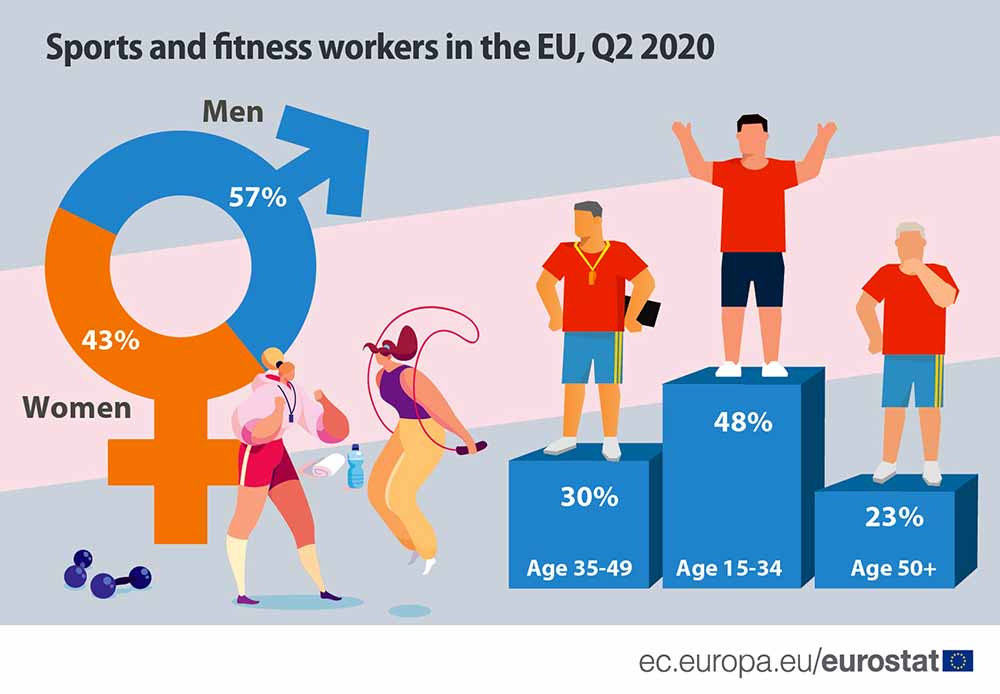
Sport and fitness workers are among those professions likely to be affected by safety measures implemented in response to the COVID-19 pandemic. Compared with the first quarter of 2020, the total number of sports workers decreased by 6%. Young sport workers aged 15-34 were the most affected (-18% for women, -13% for men).
Sweden has by far highest number of sports workers
For the EU as a whole, there were 215 sports workers per 100 000 inhabitants aged 15 and above in the second quarter of 2020.
Among the individual EU Member states, Sweden recorded by far the highest rate of sports workers (583 per 100 000 inhabitants aged 15 and above). Sweden is followed by Cyprus (340), Ireland (327), Finland (316) and Denmark (310).
In contrast, the lowest rates were registered in Belgium (81 sports workers per 100 000 inhabitants aged 15 and above) and Romania (87), followed by Poland (109), Czechia (123) and Slovakia (128).
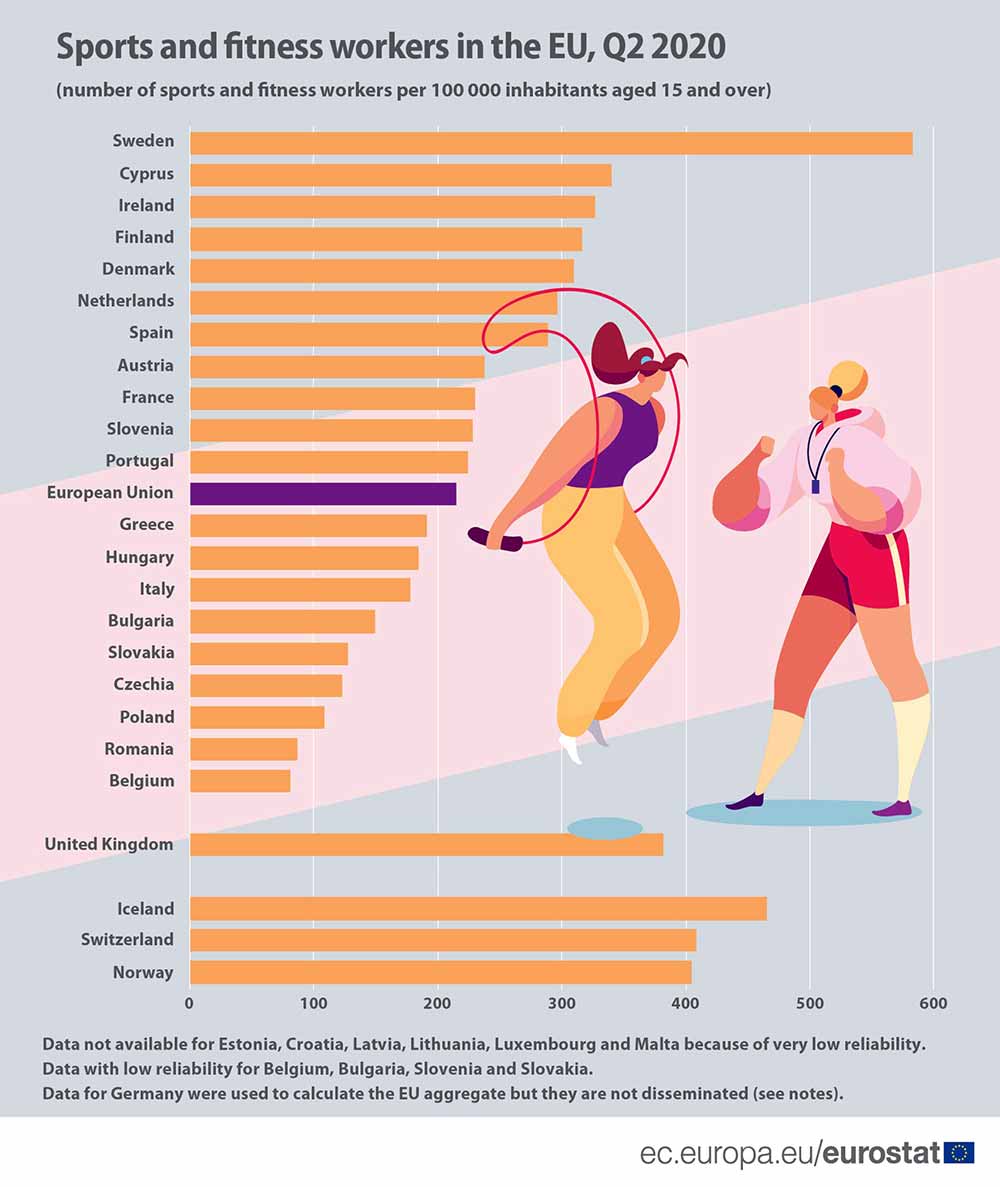
Main indicators for assessing labour market risks
The indicator lose the job is built based on the longitudinal Labour Force Survey data in quarter 2. Eurostat considers a person employed in quarter 1 loses the job in two different situations:
- if the employed person transitions to unemployment defined according to the ILO definition or
- if the employed person transitions to inactive but remains close to the labour market or the self-defined status is unemployed.
Losing your job
Three categories of discouraged persons are identified based on whether they are or not available to start a job, their willingness to get a job and their approach to seek employment, similar to the labour market slack indicator. Overall, the later category refers to those persons who were without work and available for work but did not look for work, believing that they have no chance to get employment.
There was a clear increasing trend in this category for most countries during quarter 2. Individuals could not search for work or were not available due to the lockdown. These are not counted as unemployed according to the ILO concept but are included in our lose the job indicator.

The second indicator for labour market risks is essential for any microsimulation exercise in the current context. It is composed of a) temporary layoffs or people absent from work and b) people with reduced working hours. One of the immediate and tangible effect is the reduction in the number of hours actually worked by employees. We find reduction of working hours even in temporary cessation of activity in many sectors of the economy.
Labour Force Survey – LFS
When available the explicit variable on absence due to COVID is used. It is included on an exceptional basis in the second quarter of the LFS survey in some countries. If not available, a derived indicator on absences is computed based on core LFS variables. The later option of the indicator was validated using two criteria:
- most countries had a larger than ten fold increase between Jan and April for absences in these categories
- it was rather close to the COVID question on absences for countries where the explicit question was asked.















